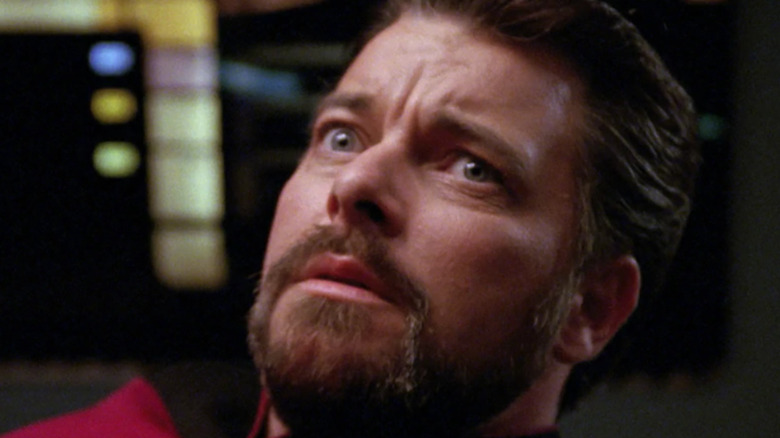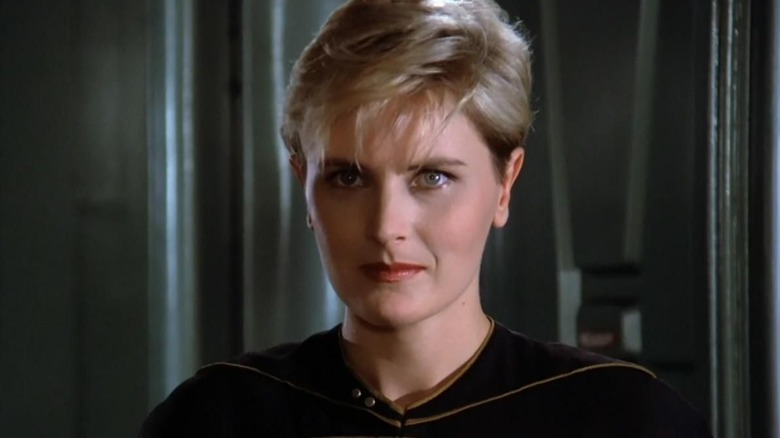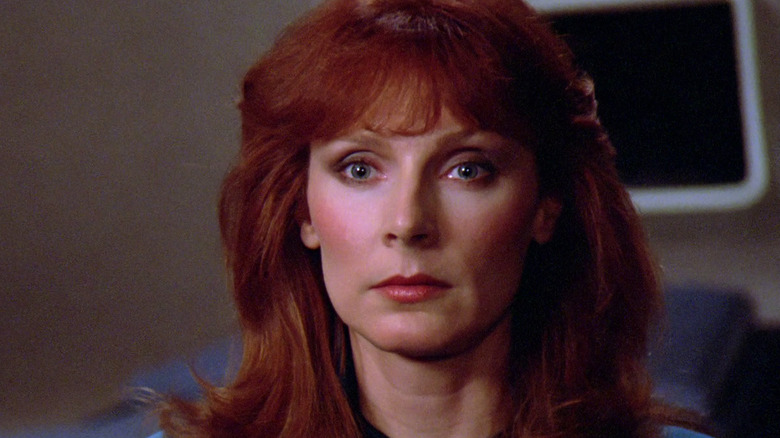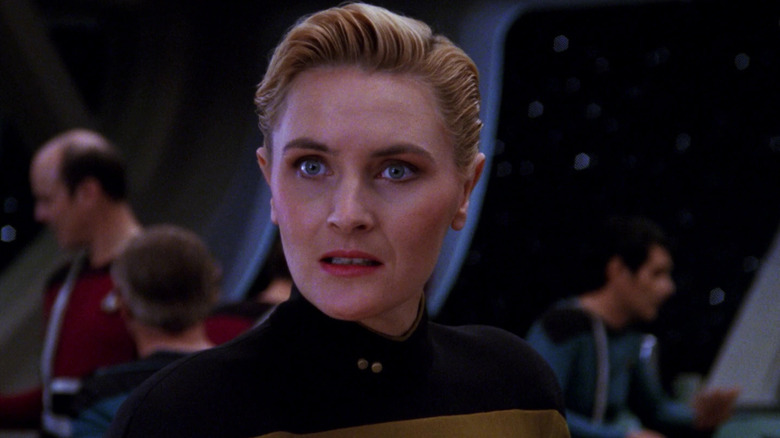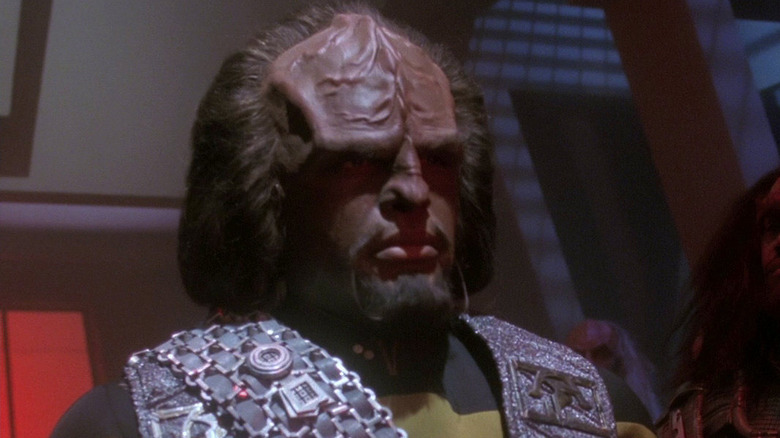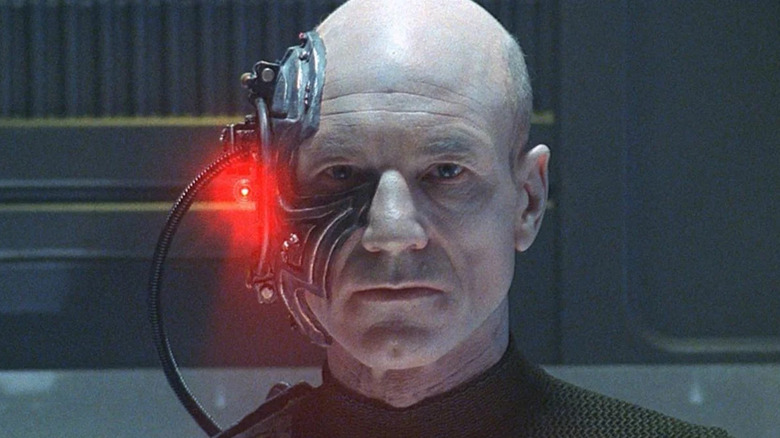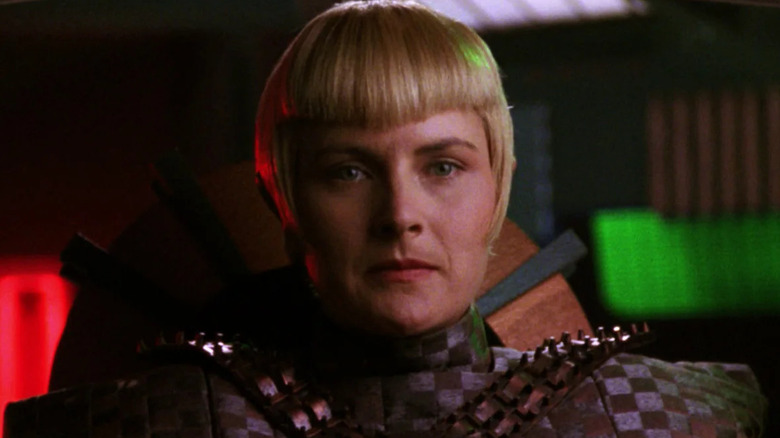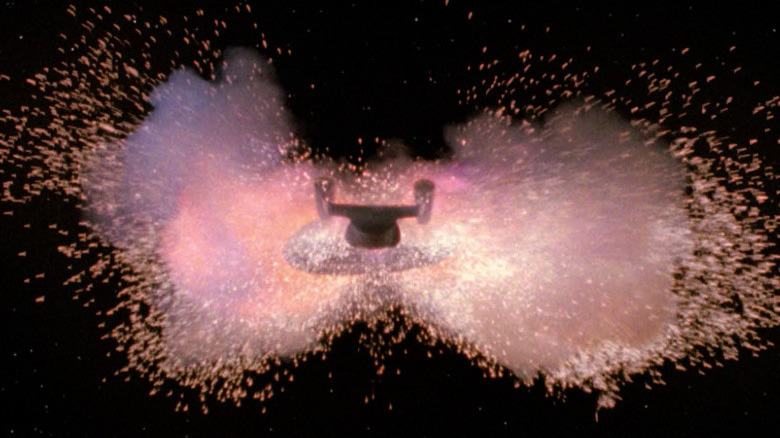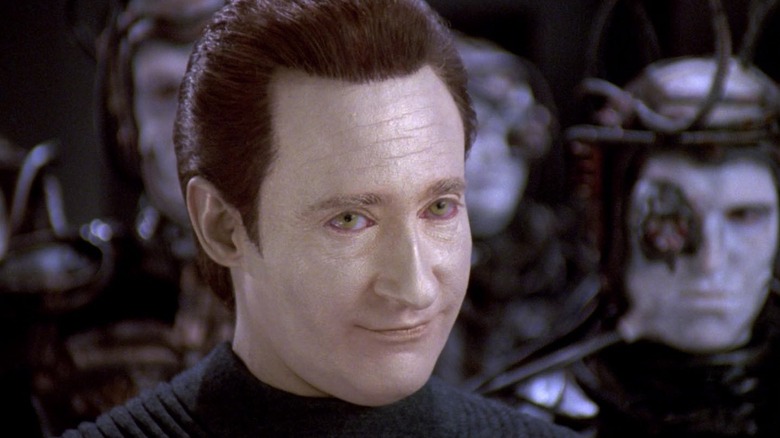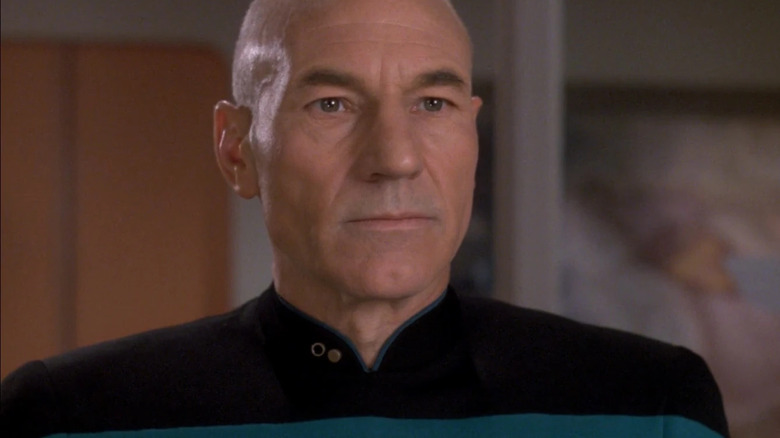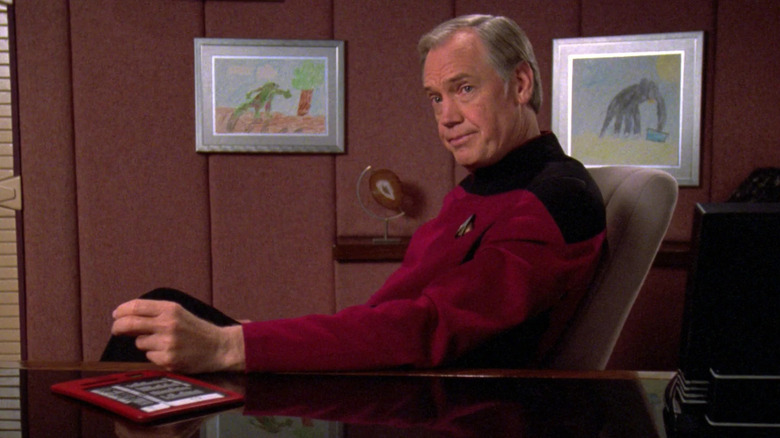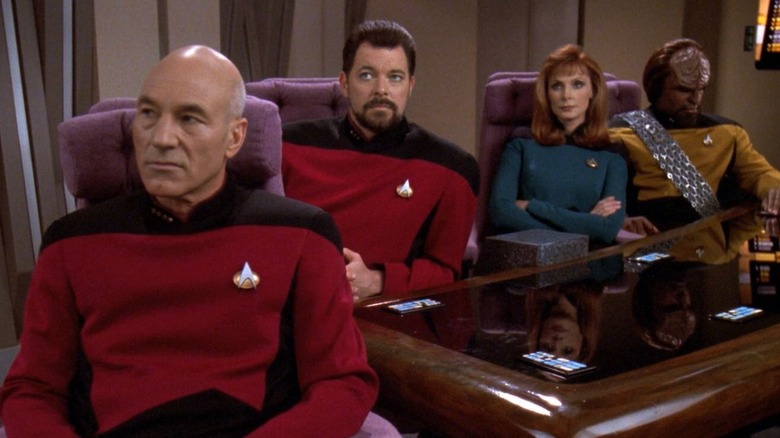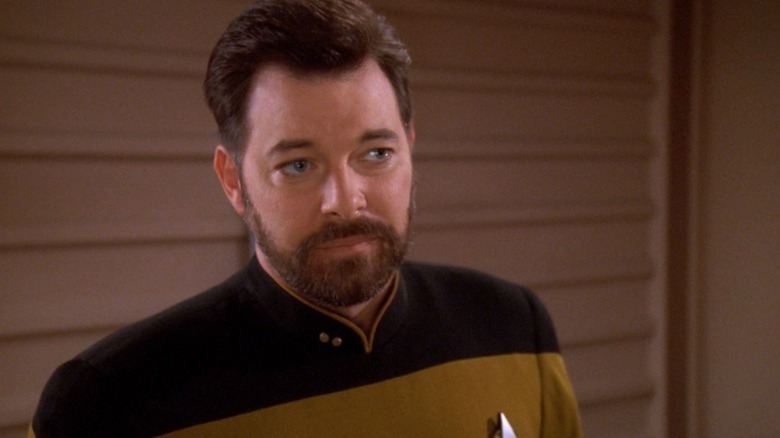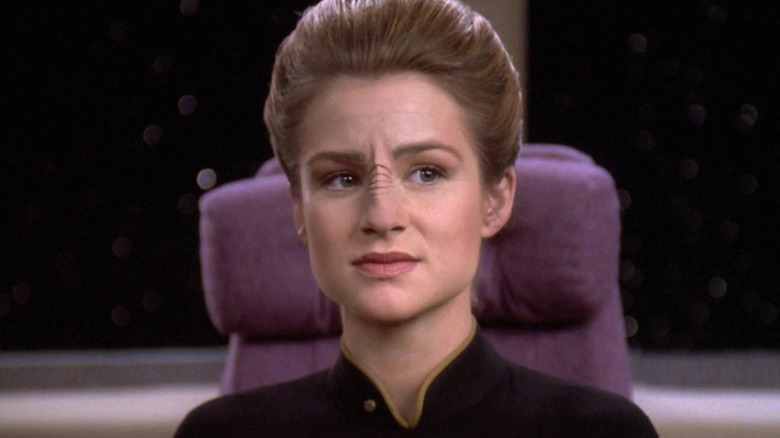The Most Unexpected Things To Happen In Star Trek: The Next Generation
The "Star Trek" franchise is known for its many starships and crews seeking out new life and new civilizations, and boldly going where no one has gone before; for family friendly science fiction adventures and thought provoking tales with social and political allegories. While certainly not a predictable series, "Star Trek: The Next Generation" wasn't exactly known for stories that delivered daring, bold, shocking events.
While shows today are more known for surprising storylines, sudden character deaths, and startling betrayals, "The Next Generation" was a much humbler series, with weekly episodes home to calmer fare. An episodic series that didn't rely on gimmicky shock value stories, viewers could get comfortable knowing that from episode to episode they'd get quality stories with strong characters, and a dramatic conclusion.
But over the course of its seven year run, "Star Trek: The Next Generation" still gave us its share of unexpected moments and staggering twists, most often in season-ending cliffhangers that left Trekkies frustrated all summer long. But whether it was a twist at the break of a two-parter, or the exit of a long-running character, here's the most unexpected things we saw on "TNG."
The death of Tasha Yar
While shows today like "The Walking Dead" and "Game Of Thrones" seem to kill off main characters every other episode, in the mid 1980s the exit of a series regular was rare, and it was a major television event when it occurred. This made it all the more astonishing when the Enterprise-D's security chief Tasha Yar — played by Denise Crosby — was killed off in the unspectacular and non-event episode "Skin of Evil."
The series was only in its first year and not yet a smash hit, so perhaps that explains why the show did not make a big deal out of the loss of a major character. It was also not done for ratings like other TV deaths, instead the result of Crosby requesting her release from the series. Nevertheless, the decision to kill off the character, rather than simply write her out of the series, left fans' mouths agape, as the family friendly franchise wasn't exactly known for its shocking deaths. Though Mr. Spock had been killed off in 1982's "The Wrath of Khan" just five years earlier, he made a quick return in the follow-up film "The Search for Spock" two years later. Could Yar follow suit?
The exit of Doctor Crusher
Perhaps the producers of "Star Trek: The Next Generation" learned from the death of Tasha Yar when they wanted to push out actress Gates McFadden after the ending of the series' first season. Fired from the show after disputes with head writer Maurice Hurley, audiences were surprised when they tuned into the first episode of the show's highly anticipated second season, "The Child" to see a new Chief Medical Officer on the bridge of the Enterprise: Dr. Katherine Pulaski.
Thankfully, the writers opted not to kill off the well-liked Dr. Crusher, choosing instead to mention that she was now off at Starfleet Medical. This also allowed the show to retain Crusher's son Wesley, another series regular, without having to deal with the fallout of his mother's death. But what made this major change to the series all the more unexpected was that Dr. Pulaski was not well-liked by the fanbase during her time on the show. Thankfully, producers realized that the change had been a mistake, and with head writer Maurice Hurley departing the series before the third season, actress Gates McFadden was brought back. Doctor Crusher returned from her sabbatical at Starfleet Medical to resume her duties aboard the Enterprise D, and remained through the rest of the series and subsequent films.
Tasha Yar returns in an alternate timeline
As "Star Trek: The Next Generation" continued its run, it dramatically improved after its first few seasons, with many fans and critics agreeing that the beginning of its third year marked a turning point in quality. That season included a number of key episodes, some of which became all-time classics, capped off with the epic two-part season ending cliffhanger, "The Best Of Both Worlds." But it was a little episode in the middle of the season that delivered a number of unexpected moments: "Yesterday's Enterprise."
When the previous Enterprise from the past — the Enterprise-C — is thrown into the future, reality is changed and a new timeline is forged with several unexpected twists. In this alternate reality, the Federation is at war with the Klingon Empire. Just as important, however, is that Tasha Yar is alive and the ship's chief of security. When the crew realize they must send the Enterprise-C back and restore the timeline — and that Yar is dead in the restored reality — the newly revived Tasha volunteers to go back in time to help the Enterprise-C complete its suicide mission to save history. The episode proved to be an all-time great, and Yar gets a better story in one episode than she received throughout the entire first season.
Worf is exiled
One of the hallmark's of '80s "Star Trek" was its episodic nature, where each episode could stand on its own with no knowledge of prior episodes. But all that changed in third season episode "Sins Of The Father," which sets Lieutenant Worf on a new path — one that would ultimately come to define his character over the next decade. In the episode, Worf's previously unknown brother comes aboard to inform him that their late father has been posthumously accused of treason. If they don't fight the charges, they too will be branded traitors.
For the first time in "Star Trek" history, we visit the Klingon homeworld of Qo'nos. Worf discover that it was the dead patriarch of a rival Klingon family — the Duras clan — that had betrayed his people, not his father. Unfortunately, the House of Duras is a powerful one, and for the sake of keeping the Empire from falling into civil war, Worf must accept the lie of his father's betrayal and be permanent exiled from his fellow Klingons. It's a stunning conclusion to an episode viewers may have been sure would end with Worf getting justice. Instead, he is the victim of a corrupt system, and in being shunned, it kickstarts an ongoing subplot that would last for several seasons — even carrying over into the spinoff series "Deep Space Nine."
Picard becomes a Borg
Featuring a double dose of surprising events, the third season finale "The Best Of Both Worlds" is often voted the best episode of the series, and sometimes among the best of the entire franchise. The first part of the two-part story set the television world afire, featuring the Enterprise's showdown with their most dangerous foe yet: The Borg. When just one Borg Cube destroys an entire fleet of Federation starships, it looks like nothing will stop it from destroying Earth. But on top of the terrifying threat to the Federation, it was even more chilling when Captain Picard was kidnapped by the Borg, with his body and mind used as a cybernetic host to become their new leader, Locutus.
As audiences sat perched on the edge of their seat wondering how the crew would save Picard, Starfleet promotes Riker to captain of the Enterprise, and orders the destruction of the Borg ship — with Picard still onboard. As Riker calls for an attack, a title card reading "To Be Continued" appeared on the screen. A cliffhanger like this was entirely unexpected for most audiences, who must have wondered if losing Picard and having Riker as captain would be the new status quo. Fans would have to wait all summer for an answer, and the anticipation for the fourth season was palpable.
Yar returns as Commander Sela
The fourth season finale "Redemption, Part 1" was the culmination of the multiple ongoing background subplots, most notably that of a mysterious Romulan plot to spark a war between the Federation and the Klingons. It also tied in the story of Worf's exile and blood feud with the House of Duras. But it was the episode's reveal of the shadowy Romulan commander (seen previously in silhouette only in the episode "The Mind's Eye") that delivered the biggest surprise. Though she went unnamed here, the Romulan is a dead ringer for former Enterprise security chief Tasha Yar, and was in fact played by actress Denise Crosby.
It was an eye-opening reveal for fans, with no explanation for how or why this new Romulan villain bore such a strong resemblance to Yar. Though it couldn't quite match the devastating reveal seen in "The Best Of Both Worlds" it nevertheless delivered a nail-biting finish and left audiences wondering what the heck was going on. And in the days before the internet, it was the purview of fan magazines and water cooler talk, as audiences speculated who this Romulan commander was and what her connection to Tasha Yar might be.
The destruction of the Enterprise
On the evening of March 23rd, 1992, audiences tuned in to "Star Trek: The Next Generation" to find a story in media res: the Enterprise was being rocked by explosions, with casualties reported all over the ship and the captain looking panicked. As Geordi announced that the warp core must be ejected, Commander Riker ordered everyone to escape pods. Then, Captain Picard gave a fateful order, telling the crew to abandon ship. But it was too late — fires broke out across the bridge, and as it cut to an exterior shot we saw the Enterprise being rocked by an unseen force. Then, the unthinkable happened: The ship exploded, incinerated in a fireball that encompassed the screen.
As actor Patrick Stewart read out those iconic words, "Space: The Final Frontier..." in the series' iconic opening narration, audiences wondered how the heck the rest of the episode would play out now that the ship and its crew had been destroyed. It wouldn't be long before we discovered the Enterprise was caught in a time loop, reliving its destruction over and over, and the crew forced to find a way out and stay alive. But for one brief moment, it was perhaps one of the most unexpected things to ever happen on "Star Trek."
Lore leading the Borg
Another season ending cliffhanger, "Descent" rarely ranks among Trekkie's favorite episodes, as it's a fun but otherwise unremarkable two-parter. But its climax was certainly an unexpected reveal that deserves a place on this list. The episode sees the return of the Borg — the normally robotic alien tyrants who act on collective will — who begin behaving as individuals with emotions. At the same time, Data seems to be experiencing his own first feelings, and is swiftly "kidnapped" by the Borg. Pursuing the rogue alien ship to an isolated planet, Picard tracks Data's signal to a structure where they are ambushed, with Picard, Troi, and Geordi taken hostage.
As the season finale comes to its close, the Borg unveil their new leader: None other than Lore, Data's evil brother. He's joined by Data as well, and they say they're going to destroy the Federation. Fans may have thought this was just another ordinary Borg episode, so it's certainly an unexpected twist to mix the two robot adversaries together and turn the wayward Lore into the Borg's new leader.
Picard becomes a lowly crew member
Episodes with the villainous trickster called Q are always a delight, but few are better than the sixth season entry "Tapestry." A mix of a Dickens classic and "It's a Wonderful Life," the episode sees Picard die in the first moments of the episode — but that's not the unexpected moment that earns it a spot on this list. Right away, Picard awakens to find Q waiting for him in the afterlife, and offering him a chance to change his past. Reckless in his youth, Picard wants to go back and prevent a bar brawl he was dragged into in his post-Academy days that forced him to rely on an artificial heart. If he can change that regretful moment in his life, he reckons, he may survive the phaser blast that ultimately kills him.
"Tapestry" is a heartwarming episode that teaches Picard the lesson that even things in our past that we may regret are important to who we are. When he successfully averts the brawl, he's transported back into the present to find he's now a common crew member aboard the Enterprise. The reveal of Picard, clad in a blue uniform, carrying the rank of junior lieutenant, is the true unexpected turn. Given the way these sorts of "Christmas Carol" type stories go, some viewers may have expected a fateful twist, but few likely thought they'd see the powerful Jean-Luc Picard a lowly crew member being berated by Geordi LaForge.
Jellico becomes captain of the Enterprise
Unexpected moments seem to come most in two-part episodes, and our next entry is no different. In "The Chain Of Command," Picard is ordered to lead a daring covert mission into Cardassian territory to track down a devastating weapon. The episode is full of stunning moments, including Captain Picard being kidnapped and tortured. But the real unexpected moment comes when after Picard is assigned to his mission, a new captain comes aboard to take command of the Enterprise.
With a known actor — "RoboCop" villain Ronny Cox — playing the incoming captain Edward Jellico, audiences again were left to wonder if this could be a shakeup of the status quo. Picard had left the ship before, and on at least two occasions when he was thought dead, Riker was given command of the Enterprise; to have Jellico arrive and assume the captain's chair was certainly questionable. Add the episode's cliffhanger ending that left Picard at the mercy of a bloodthirsty Cardassian, viewers were left with no idea of what to expect.
The warp drive is an environmental hazard
For 25 years, warp drive had been a staple of the "Star Trek" franchise, a conceit that allowed starships to traverse the incredible distances between planets and star systems. But in the seventh season episode "Force of Nature," a shocking discovery is made: Warp engines aren't just a convenient mode of travel, but an environmental hazard that could destroy all life as we know it. In a clear allegory for global warming — or, more specifically, the hole in the ozone layer which was a controversial and much debated subject in 1992 — Picard and the Enterprise must grapple with a dubious claim by alien scientists that excessive use of warp can damage the very fabric of space.
The claims, however, prove justified when one of the scientists sacrifices herself in a warp core breach that proves her hypothesis. After her demonstration, viewers may have expected the Enterprise to simply push a button and make the warp engines more ecologically friendly. Instead, the series unexpectedly embraced the consequences of the environmental risks. In an unprecedented change that would last for the remainder of the series, the Enterprise was instructed by Starfleet to limit their engines to warp five.
A duplicate Riker that survives the episode
From genetic clones to parallel reality variants, duplicate versions of main characters are a common trope in science fiction. Typically however, the duplicate leaves by the end of the episode or movie — either back to their reality or through a tragic death.
But "Star Trek: The Next Generation" put a twist on the age old duplicate story, with the sixth season episode "Second Chances." The Enterprise encounters a doppelganger of Commander Riker on a planet he'd visited nearly a decade before — the result of a transporter accident. The episode is mostly a character drama, as Riker's duplicate — who had been trapped on the planet for years — is essentially the man he was when he was young. Forced to confront things about himself he doesn't care for, along with many of his own life regrets, the episode sees the new Riker, dubbed Thomas, attempting to rekindle his romance with Counselor Troi.
A climactic scene saw the two Rikers teaming up to enter a dangerous cavern, and there was a moment where seemingly only one Riker would make it out alive. Fans likely expected the duplicate Thomas Riker to sacrifice himself to save William Riker, but in an unexpected turn of events, they both survive the incident. The episode ended with the unprecedented — and frankly bewildering — realization that there would forever be two versions of Riker in the "Star Trek" universe.
Sito Jaxa is killed off-screen
The episode that inspired the animated spinoff by Mike McMahan, "Lower Decks" was a unique story during the seventh season of "Star Trek: The Next Generation." It focused almost entirely on four low-level crew members and the challenges they face during a round of promotions aboard the Enterprise. The four include Ensign Lavelle, Vulcan Ensign Taurik, longtime recurring character Nurse Ogawa, and Ensign Sito Jaxa — the last of whom had been part of a cover-up alongside Wesley Crusher at Starfleet Academy in the fourth season episode "The First Duty." But when a Cardassian defector arrives on the ship, Picard recruits the young and idealistic Ensign Jaxa to help return him to Cardassia safely.
The plan is for Jaxa — a Bajoran — to pose as the Cardassian's prisoner, to provide cover should he be stopped by his local authorities. Once returned to Cardassian space, he would leave Jaxa in an undetectable escape pod for the Enterprise to retrieve. But in an unexpectedly dark ending, Picard announces to the crew that Jaxa was killed on the mission, leaving her three friends gasping in shock — likely the same reaction from viewers, who were not used to these kinds of downer endings on the upbeat "Next Generation." To cap off the otherwise light-hearted episode with the off-screen death of a young, wide-eyed officer was as unexpected as any on this list.
